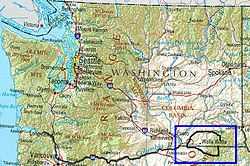| Wine region | |
 | |
| Type | American Viticultural Area |
|---|---|
| Year established | 1984[1] 2001 Amended[2] |
| Years of wine industry | 184[3] |
| Country | United States |
| Part of | Washington, Oregon, Columbia Valley AVA |
| Sub-regions | The Rocks District of Milton-Freewater AVA |
| Growing season | 190 to 220 days[1] |
| Climate region | Continental/Mediterranean |
| Precipitation (annual average) | 10 to 20 inches (254–508 mm) Avg: 12.5 inches (317.5 mm)[1] |
| Soil conditions | Loess soil, unstratified calcareous silt[1] |
| Total area | 178,560 acres (279 sq mi)[1] Amended 3,500 acres (5 sq mi)[2] |
| Size of planted vineyards | 1,200 acres (486 ha)[4] |
| Grapes produced | Barbera, Cabernet Franc, Cabernet Sauvignon, Carmenere, Chardonnay, Cinsault, Counoise, Dolcetto, Gewurztraminer, Malbec, Merlot, Nebbiolo, Petit Verdot, Pinot noir, Sangiovese, Semillon, Syrah, Viognier[4] |
| No. of wineries | 20[2] |
| Wine produced | Varietal, Dessert wine, Sparkling wine, Meritage |
| Comments | The AVA (located within the black outline in the blue box) extends south into Northern Oregon |
Walla Walla Valley is an American Viticultural Area (AVA) located within Washington state and extending partly into the northeastern corner of Oregon. The wine region is entirely included within the larger Columbia Valley AVA. In addition to grapes, the area produces sweet onions, wheat and strawberries[3] After the Yakima Valley AVA, the Walla Walla AVA has the second highest concentration of vineyards and wineries in Washington State.[3] Walla Walla hosts about 140 wineries.[5] The area was recognized on March 7, 1984 by the Bureau of Alcohol, Tobacco and Firearms (ATF), Treasury after reviewing the petition submitted by Mr. Richard L Small, President of the Walla Walla Valley Winegrowers Association, for the establishment of a viticultural area in southeast Washington and northeast Oregon, east of Lake Wallula, to be known as "Walls Walls Valley." At the time, Walla Walla Valley viticultural area was approximately 178,560 acres (279 sq mi) with two bonded wineries and about 60 acres (24 ha) from several vineyards.[1]
- ^ a b c d e f "Establishment of the Walla Walla Valley Viticultural Area" (27 CFR Part 9 [T.D. ATF-165; Re: Notice No. 4711] Final Rule). Federal Register. 49 (25). Bureau of Alcohol, Tobacco and Firearms (ATF), Treasury: 4374–4376. February 6, 1984. Archived (PDF) from the original on April 18, 2021.
 This article incorporates text from this source, which is in the public domain.
This article incorporates text from this source, which is in the public domain.
- ^ a b c "Realignment of the Boundary of the Walla Walla Valley Viticultural Area and the Eastern Boundary of the Columbia Valley Viticultural Area (99R–141P)" (27 CFR Part 9 [T.D. ATF–441; RE: Notice No. 898] RIN: 1512–AA07 Final Rule). Federal Register. 66 (38). Alcohol and Tobacco Tax and Trade Bureau (TTB), Treasury: 11540–11542. February 26, 2001. Archived (PDF) from the original on April 18, 2023.
 This article incorporates text from this source, which is in the public domain.
This article incorporates text from this source, which is in the public domain.
- ^ a b c Parker, Tom (September 1, 2002). Discovering Washington Wines: An Introduction to One of the Most Exciting Premium Wine Regions. Seattle, Wash: Raconteurs Press. pp. 20-21, 39-44, 92. ISBN 0-9719258-5-2.
- ^ a b "Walla Walla Valley (AVA): Appellation Profile". Appellation America. 2007. Archived from the original on September 28, 2008. Retrieved January 30, 2008.
- ^ "Walla Walla Wineries". GoTasteWine.com. May 26, 2020.
© MMXXIII Rich X Search. We shall prevail. All rights reserved. Rich X Search
